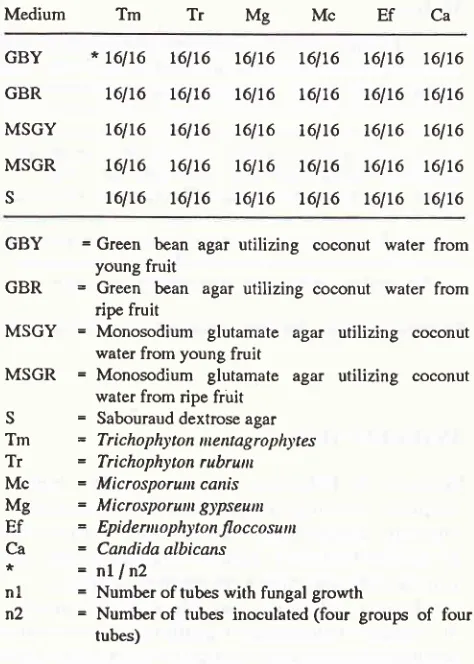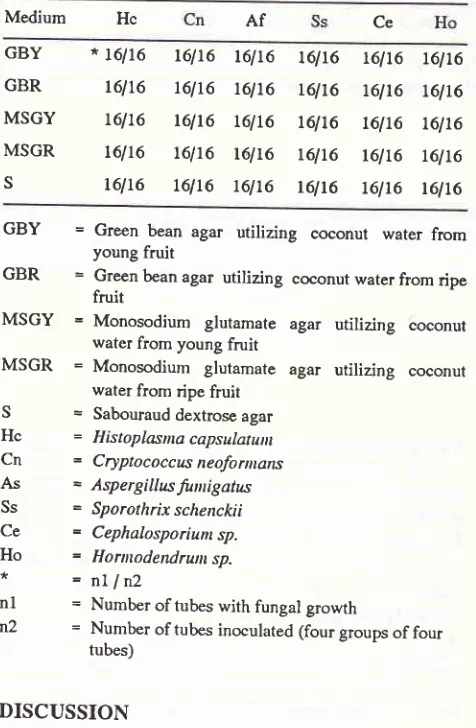Vol 4, No 2, April-June, 1995 AlternativeMediutnforMycological
Diagnosis
87Alternative Media
for
the
Mycological
Diagnosis
of
Fungal Infections in
Rural Areas
Jan Susilo
Abstrak
Karenapenyakft infeksi olehkutnan,virus danparosit nasihbanyak ditenul<an di Indonesia,
naka
sebagian besar perhatian dokter dicurahkan untuk kemungkinan infeksi oleh penyebab tersebut di atas. Penyakit janrur jarang dilaporl<an di Indonesia. Hal lersebut dapat disebabkan oleh larangnya perhatian atau l<csulitan dalan penbuktian secara laboratoris. Meskipun banyak terdapat laboraloriunt mikrobiologi, tidakbanyak yang nrelalatkanpeneriksaanterhadap jamur. Salah satusebabnya ialah,agarSabouraud delcstrosa, nediuttt standar untuk isolasijanur, mahal harganya dan masih
diinpor dari luar negeri. Suatu nediuttr alternatif yang nrcnggunalran bahan yang mudah didapat dan nwrah, yaitu air kzlapa (dari buah nudn[Y] anu
buah tua [R]), tepung kacang hijau (GB) atau nonosodiwn glutannt (MSG) dan agar, telah dikcnulalan. Penelitian ini dilakakan untuknenilai nediun baru
tersebutsebagai pengganti agar Sabouraud del<strosa (S), untuk pertuntbuhan 12 strain
janur. Tiap strain dibiakkan
pada nasing nasing 4 tabung GBY, GBR, MGY, MSGR dan S. Percobaan ini diulang etnpatkali.
Diusahakan untuk mentbiakkanI
mm3janur
pada tiap tabung. Tabungyang telah
diinokulasi
disimpanpada
suhu kanardan dinilai
setelahsatu
ninggu. Hasil penelitian
ini
menuniukkan bahwa tidak terdapat perbedaan antara agarair
kzlapa lacang hijauatau
agarair
kel.apa nonosodiutn glutanat dan agar Sabouraud dekstrosa untuk pentbialcan beberapa spesies jatnur yang sering menimbulkan kelainan pada nnnusia. Hasil tersebutnrendukung pendapat bahwa kedaa nediwn yang diajukan dapat digunakan sebagai pengganti agar Saboraud dekstrosa.
Abstract
As bacterial, viral and parasitic infections are still in Indottesia, ntost attetûion olthe physicians are drawned ro these possibilities. Mycoîic infectiors in Indonesia have been reported rarely. This could be due to inadequate attention of the phl,sicians or dfficulty in laboratory confirnntion. Although tftere are nnny nicrobiology laboratories, not ilnny nDrcsllgical exaninations were done. one
of
the reasors is that Sabouraud dêxtrose agar, the standard nediunfor the kolation offungi, is expensive and still intported. An alternative nediutn usitrg locally available and cheap inçredients, nanely coconut water (fron young [Y] or ripe[R]
fruits), green bean (GB)flour
or nronosodiuttt Slutanwte (MSG) and agar, wc$ proposed- This research was aimed to evaluate the proposed new nediun as a possiblesubstitute
for
Sabouraud dextrose agar (S)for
the growth of 12 strains offungi. Each of the futrgal isolates were cultured infàur tubesof GBY, GBR, MSGY, MSGR and S. These tests were repeatedfour tines. Care was taken to transfer about
I
cnm of inoculint in each tube. AII cultures'reere Put in roont te,nperature and evaluated one week after inoculation. Results showed that there is no significant difference between green bean cocotrut water agar or tnonosodiun gluta,,nte coco,'tut vtater agar and Saboutaud dextrose agarfor theSrowth of several species of fungi which are co,nnto,l etiologic agents of ntycoses in nan, thus confirning that the two
propisei
ntedia could be used as substitutefor
Sabouraud dextrose agar.Keywords : Mycosis,. ntediun, Sabouraud agar, coco,'tut water, green-bean flour, nonosodiun glutat,nte
INTRODUCTION
Mycoses
in
Indonesia, as
in
many other tropical
countries, are
not getting their
fair share
of
attention.
Although
temperature,
humidity and
environment
areoptimal for
fungal growth
almost anywhere,
notmany
mycotic infection
werereported
or
known.
Fungal
infections,
notably systemic
mycosis,
are
seldom
recognized
or confirmed
by
laboratory
examinations in rural as
well
as in urban
areas.Diag-nosis
of
acutesuperficial
fungal
infections
is usually
based on clinical signs andsymptoms. This may not be
easy in chronic cases, particularly if thereis
secondarybacterial
infection.
In
systemic mycosis, signs
andsymptoms
are
not
characteristic
and
could not
bedifferentiated from
other systemic
infections.
Myco-logical
examinations
are
necessary
to
confirm
the diagnosis.As bacterial,
viral and
parasitic infections
are stillprominent
in
Indonesia, most attention
are drawnedto
88 Sasilo
these possibilities.
Although
there aremany
clinical
laboratories
inthecities
andhealth
carecenters found
in
villages,
mycological
examinations are
seldom done.This
is due to the lackof expertise in
the partof
the
laboratory
technicians and theunavailability
of
themedium
to isolate the causative fungus.Most
bacterial
and
mycological
media
arestill
imported
from
other
countries.
The
increasing prices of
thesemedia,
theproblem
of continuous supply
of
themedium
and theeasily deteriorated
dry medium
dueto high
humidity
lead
to
the
high
cost
of
mycological
examinations.Although
many mediafor
theisolation
of
bacteria
aresuitable for
the
growth of
fungi,
bacteriological
ex-aminations
are evaluatedin
three orfour
days.Most
of
the
fungal
pathogenstake
much
longer time
to
grow.
This
is oneof the
reasons
why
mostof
the pathogenicfungi
arenot
isolated.
This
paper presents analterna-tive
medium
for
the
isolation of
fungi from clinical
specimens,
using
locally available
and cheapagricul-tural
products as
a
substitute
for
the
standard
Sabouraud
dextrose
agar.As
these media are intendedto
be
usedin
rural
areas,
the
methods proposedto
make the
media
do
not
employ
sophisticated
ap-paratus.MATERIALS
AND METHODS
Efforts
were made
to
replace
the
ingredients
of
Sabouraud dextrose
agar
with
locally available
andcheap
agricultural
product.
As
the
base
for the
medium,
agar,which
isusually
used to makepudding,
was
usedto
replace the more expensive
andpurified
bacteriological
agar.Dextrose
anddistilled
waterwere
replaced
with
coconut-water, which contains 4-5
%carbohydrate
and minerals.
Pepton as
the
source
of
protein
was substituted
with
green bean
flour
or
monosodium glutamate which
arecommercially
avail-able.
Agar powder is sold in
a
7 gr
packagewhich
is
recommended to
make
I
liter
ofpudding. Two of
these packages weredissolved
in
1.5 I of coconut waterfrom
young or
ripe
coconut
fruit.
Two
tablespoonful
(aboutl0
gr) of
green
beanflour or
monosodium glutamate
was
added.The
mixture
was
boiled
and dispensedin
test
tubes, each
containing
5
ml
of
the
liquid
agarmixture. Then the
tubes
were
stoppered
with
cotton
plug,
put into
pressure cooker and
boiled
for
15minutes. These tubes
could
also besterilized
byboiling
or
steaming
for
2O
minutes.
After
sterilization
the tubes wereput
in
a slantposition
to cool.
Five
dermatophytes
and one Candida
albicans
strains isolated
from skin
scrapings, 4strains
of fungi
causing deep seated
fungal
infection
andtwo
strainsof
Med J Indones
contaminants
were
used
to
test the
green-bean
coconut-water
agar
(GBY = utilizing
coconut water
from young coconut
fruit,
GBR =
utilizing
coconut
water
from ripe
coconut
fruit)
and monosodium
glutamate agar
(MSGY
=utilizing
coconut
waterfrom
young coconut
fruit, MSGR
=utilizing
coconut water
from
ripe coconut
fruit),
Sabouraud
dextrose agar (S) was used as acomparison medium.
Eachof
thefungal
isolates was cultured
in
four
tubes
of
GBY,
GBR,
MSGY, MSGR
and S. These testswere
repeatedfour
times. Care was taken
to
transfer about
I
cmm
of
inoculum in
eachtube. All cultures were put
in
room
temperature and evaluated one week
after inoculation.
RESULTS
All
five
dermatophytes
andCandida albicans
isolatesgrew
in
every
tubeof GBY,
GBR,
MSGY,
MSGR
andS and the fungi could be identified after one
week
(Table
1).Table 1. The growth of 6 isolates of fungi on 5 different media
Medium Tm
Tr
Mg
Mc
Ef
CaGBY
GBR
MSGY
MSGR s
*
L6lt6 t6lL6
t6lt6
L6lt6
r6lt6
t6lt6
L6lr6
t6lt6
t6lt6
L6lr6
t6lr6
L6lt6
t6lr6 t6lr6
r6lt6
t6ll6
r6lt6
t6lt6
r6lt6
t6lr6
t6lt6
t6lt6
t6l16
16lt6
t6lt6
t6l16
16lt6
t6lL6
16/16
r6lL6GBY
= Green bean agarutilizing
coconut water from young fruitGBR
=
Green bean agarutilizing
coconut water from ripe fruitMSGY
MSGR
S
Tm
Tr Mc
Mg
Ef
Ca
*
n1 n2
=
Monosodium glutamateagar
utilizing
coconut water from young fruit=
Monosodium glutamateagar
utilizing
coconut water from ripe fruit=
Sabouraud dextrose agar=
Tr icho phyton, ne ntag ro p h), tes=
Trichophyton rubrwn=
Microsporutn canis=
Microsporunt gypseunt=
Ep i d e n t o ph1, to n flocc osut tt=
Candida albicans=
nlln2
=
Number of tubes with fungal growth=
Numberof
tubes inoculated(four
groupsof
four tubes) [image:2.595.315.552.361.693.2]-Vol 4, No 2, April-June, 1995
mans,
Aspergillus
fumigatus
andSporothrix schenckii
modendrum
spevery tubes
of
dextrose
agarTable
2.
The
growthof 4
isolatesof
fungi causing systemicfungal infection and 2 isolates of contaminantson 5
different media
AlternativeMediunforMycological
Diagnosis
g9Medium Hc
GBY
*
L6lt6 t6lt6 t6lt6 t6lt6
r6lt6
t6lt6
GBR
t6lt6 t6lt6 t6lt6 r6lt6 t6lt6
L6lL6MSGY L6lr6 t6lt6
L6lL6
t6lt6
t6lL6
t6lt6
MSGR r6lt6 t6lt6 t6lt6 r6lt6
t6lL6
L6lt6
s
16/16 L6lt6
t6lt6 t6lt6 t6lt6
t6lL6
dextrose agar.
The fungi
cultures
could
be
identified
after one week.
More
species and strainsof
otherfungi
should be tested. As the
fungi
tested were isolatesfroà
clinical
specimens, excepttwo
strainswhich
werecon-taminants, the proposed media should be able to
isolate
causative
fungi directly from clinical
materials.
Isola_research
was
to find
a
cheap
and
locally
available
ingredients
to
make
mycological
media
to
substitute
the expensive and
imported
Sabourauddextrose
agar.As these
media
were madewithout
employing
sophis_ticated apparatus, these media
could
be made almostin
any laboratory or health
care centers.The
low prize
andeasily available ingredients
tomake these
media
could helpmedical
doctors andtheir
staff to
make
their own medium
almost anywhere
in
Indonesia
or
in
any other tropical countries.
TheseCONCLUSION
Alternat
ing
coconut water,
green-bean
flo
glutamate
and agar can beused
to
are as good as
Saborauddextrose agar.
REFERENCES
l.
Emmons CW, Binford UJ, Kwon Chung.C, editors. New York: Lea&
Febiger, 19782.
RipponfW.
MedicalMycology.
philadelphia: Saunders,1988.
3.
Susilo L An alternative medium for the isolation of fungi andsome effort to improve the diagnosis and managemint
of
mycoses [disertation]. Jakarta: University
of
Indone,sia, t992.Ce
Af
GBY
GBR
MSGY
MSGR
s Hc Cn As
Ss
Ce
Ho
*
nl
n2
=
Green beanagar
utilizing
coconut water from young fruit=
Green bean agarutilizing
coconut water from ripefruit
=
Monosodium glutamateagar
utilizing
coconutwater from young fruit
=
Monosodium glutamateagar
utilizing
coconutwater from ripe fruit
=
Sabouraud dextrose agar=
H istoplasnta capsulatu,,t=
Cryptococcus neofo rnwns=
Aspergillusfumigatus=
Sporothrix schenckii=
Cephalosporium sp.=
Hornodendrunt sp.=
nlln2
=
Number of tubes with fungal growth=
Number of tubes inoculated (four groups of fourtubes)
DISCUSSION
Results
of
the
testsshowed
that
the proposed media
were able
to
grow fungi isolated from
patients
and [image:3.595.44.282.206.570.2]
